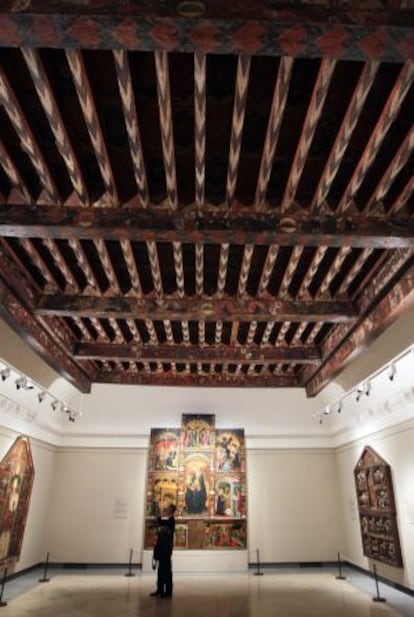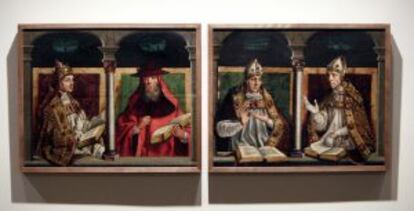All looking up at the Prado
The museum's latest addition is a spectacular medieval coffered ceiling Donated by the Várez Fisa family, it depicts dragons, bear hunts and busty maidens

As if there weren't enough reasons to go back to the Prado museum, here is a new one: an enormous pinewood coffered ceiling, covering 66 square meters and weighing six tons, that depicts a constellation of scenes ranging from bear hunts, Biblical tales and coats-of-arms from Castilla y León, to busty women with tiny waists, harpies and dragons.
The work was created around 1400 - it is impossible to know by whom - for the choir loft inside the church of Santa Marina de Valencia de Don Juan in León. After 1970 it adorned one of the rooms inside the family home of José Luis Várez Fisa, an engineer, entrepreneur and devoted art collector.
But from this week the coffered ceiling is now resting inside the Prado's medieval wing, in the Villanueva building, as part of a larger donation by the Várez Fisa family that was announced in February.
Another 17 artworks made between 1200 and 1500, many from the kingdoms of Aragón, Valencia and Catalonia, are distributed in the new Várez Fisa Hall under the imposing tree-like presence of the ceiling - the hanging of which caused many a sleepless night for Enrique Nuere, the architect, carpenter and scholar entrusted with figuring out how to do it.
The donation is a tribute to the generosity of art patronage at a time when everyone talks about its convenience, yet nobody - at least, nobody with the power to effect change - is lifting a finger to encourage it.
Besides the selflessness of the gesture, the donation also fills one of the largest gaps in the Prado's vast collection. That is why Gabriele Finaldi, associate director of curatorship and research, defined the new addition of 18 medieval artworks as "transformative."
The ceiling was created around 1400, but it is impossible to know by whom
"It's already hard enough finding one work of art that's fit for the Prado," notes Finaldi. "So offering a lot like this one, which actually alters the entire physiognomy of the holdings, seems like an impossible task."
Várez Fisa's donation includes Retablo de San Cristóbal (Altarpiece of Saint Christopher), already a familiar sight at the Prado since the entrepreneur, who would later become a trustee of the museum, donated it in 1970.
Even before this latest donation, Prado director Miguel Zugaza had already inducted Várez Fisa into the hall of fame of the museum's major donors, who also include Ramón Errazu, Pablo Bosch, Pedro Fernández Durán and Francesc Cambó, a group whose personal tastes influenced a legion of art lovers in the first half of the 20th century.
When curator Pilar Silva, who specializes in Spanish painting between 1100 and 1500, offered a guided tour of this latest trove of art, it emerged that the lineage of art patrons may in fact go further back in time than initially thought. Nacimiento de Cristo con un donante (or, Birth of Christ with a donor), a 1506 painting by Fernando Llanos, an artist from Valencia and an apprentice of Leonardo da Vinci, shows an ambitious-looking man in the right-hand side of the canvas. This individual is almost certainly Ambassador Vich, a Spanish aristocrat and diplomat who was a patron of Italian artist Sebastiano del Piombo while he was stationed in Rome.

But the true identity of the donor is not the only mystery in a tour full of question marks. Some are quite literal: the signs next to some paintings include questions such as "Did Jaume Serra paint Virgen de Tobed?" Others are more conceptual, such as the uniquely masterful technique on display in the Tríptico del Zarzoso (Zarzoso triptych), which for years was considered a leading example of international Gothic art even though it was in fact Spanish.
"The painter, about whom nothing is known, had such a personal style that if any other work by him should turn up, it would be easily recognized," writes Silva in the catalogue.
No member of the Várez Fisa family was present at the event that introduced the new members of the Prado collection to the press. Zugaza explained they didn't want to "take the limelight away from the artwork." Nor did any politicians make a showing, although Queen Sofia and Education, Culture and Sport Minister José Ignacio Wert turned up to inaugurate the new hall on Tuesday. Perhaps that was because the event at which the donation was formalized - Prime Minister Mariano Rajoy's first official visit to the museum - was meant to be an acknowledgement of the selfless labor of art collectors, but came out sounding rather different after the PM said that "the patron must expect nothing in return."
And while it is true that the donors get no money and no tax benefits for a gift worth more than 15 million euros on the market, Monday's event highlighted another absence: that of the Patronage Law, which is still pending approval by the tax authorities and would in all likelihood make donation a more common practice in Spain.
Until that day arrives, it may be wise to adopt the same attitude as St Christopher in the altarpiece that was donated by Várez Fisa in 1970 - a mix between skepticism and patience.
Tu suscripción se está usando en otro dispositivo
¿Quieres añadir otro usuario a tu suscripción?
Si continúas leyendo en este dispositivo, no se podrá leer en el otro.
FlechaTu suscripción se está usando en otro dispositivo y solo puedes acceder a EL PAÍS desde un dispositivo a la vez.
Si quieres compartir tu cuenta, cambia tu suscripción a la modalidad Premium, así podrás añadir otro usuario. Cada uno accederá con su propia cuenta de email, lo que os permitirá personalizar vuestra experiencia en EL PAÍS.
¿Tienes una suscripción de empresa? Accede aquí para contratar más cuentas.
En el caso de no saber quién está usando tu cuenta, te recomendamos cambiar tu contraseña aquí.
Si decides continuar compartiendo tu cuenta, este mensaje se mostrará en tu dispositivo y en el de la otra persona que está usando tu cuenta de forma indefinida, afectando a tu experiencia de lectura. Puedes consultar aquí los términos y condiciones de la suscripción digital.
Últimas noticias
The complicated life of Francesca Albanese: A rising figure in Italy but barred from every bank by Trump’s sanctions
Half of Scotland is in the hands of 420 property owners
Reinhard Genzel, Nobel laureate in physics: ‘One-minute videos will never give you the truth’
Pinochet’s victims grapple with José Antonio Kast’s rise in Chile
Most viewed
- Pablo Escobar’s hippos: A serious environmental problem, 40 years on
- Why we lost the habit of sleeping in two segments and how that changed our sense of time
- Charles Dubouloz, mountaineering star, retires at 36 with a farewell tour inspired by Walter Bonatti
- Reinhard Genzel, Nobel laureate in physics: ‘One-minute videos will never give you the truth’
- The Florida Keys tourist paradise is besieged by immigration agents: ‘We’ve never seen anything like this’









































